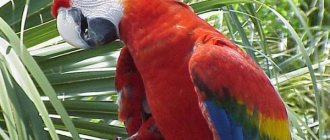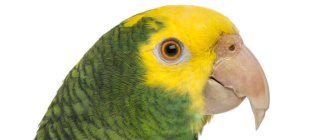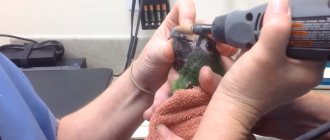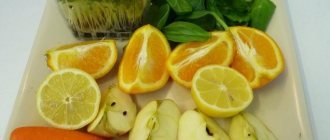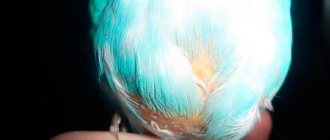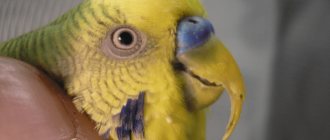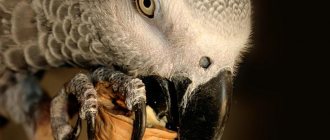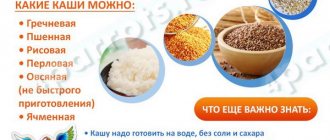Sometimes there is a situation when your pet is sick and refuses to eat, or you need to feed the weakened bird yourself. The question immediately arises: what to feed, how and how much?
First of all, notice whether the bird is eating. Due to her accelerated metabolism, she cannot live for a long time without food. If the bird refuses food for two or three days, it loses a lot of weight and dies from exhaustion. Therefore, there is a need for force feeding.
How:
It is necessary to feed the bird with dairy-free infant formulas, without adding rye or sugar, diluting them with water. If suddenly it is not possible to buy such a mixture, then you can feed it with homemade porridge. Rice, buckwheat or oatmeal is ground in a coffee grinder, boiled in water, without salt, sugar and butter, until cooked and the consistency of not very thick, but not very liquid sour cream. If you don’t have a coffee grinder, you can simply boil one of the cereals listed above and grind it to a homogeneous puree-like mass in a blender or use a mixer for this purpose. You can add a drop of honey to the porridge.
How:
The porridge is presented to the bird in a syringe without a needle. But, you must admit, not every bird will voluntarily eat from a syringe. If you feed carelessly, you are guaranteed to have your hands bitten and bleeding.
To ensure safety and convenience, it is better to wrap the bird in a towel so that it appears as if it were in a diaper. Then she will not be able to actively resist and will not harm either you or herself. It is better to squeeze the food out of the syringe into the corner of the beak, very carefully and in small portions. If the bird does not swallow, but spits, then you can try stroking the neck with gentle downward movements, towards the belly, this will provoke swallowing reflexes. Do not use eye droppers! They break easily; a parrot can bite through the glass with its beak.
When feeding, the bird must be held upright to prevent it from choking.
How many:
A sick, exhausted bird cannot always eat even from a syringe. Depending on the disease, she may feel nauseous and food may not be digested. Excess food in the crop can ferment. Therefore, it is better to feed the bird first in small portions of 3-5 mg, every 1-2 hours. Later, when the bird is recovering, you can increase the portions to 10 mg and feed, accordingly, less often.
The approximate amount of food that needs to be fed to a sick cockatiel per day is 30-50 mg.
©Any copying or distribution of materials is strictly prohibited without prior written permission.
What is necessary
You will need (buy at a regular pharmacy):
- A butterfly catheter with the thinnest tube (ideally G18) or a 2 mm feeding tube for children (the latter is more convenient, but is mainly sold only in maternity hospital pharmacies).
- Syringe 5 ml.
- Vaseline oil.
- Children's dairy-free porridge without rye, sugar, fruits and berries and other additives (preferably multi-grain, just read the ingredients carefully so that there is no rye). For example: Nestle, Nutrilon, Humana. If you don’t find one, take a monocomponent one - oatmeal, buckwheat, rice, wheat.
How long can a parrot live?
Without food
The answer to this question depends, first of all, on the state of health and age of the individual. In addition, the smaller the birdie, the faster it will weaken. A parrot can live for three or four days without food, but then its condition worsens, feathers begin to fall out and it may die.
If it is not a matter of stress and there are signs of poor health of the bird, it is urgent to show it to a specialist. When it is not possible to do this immediately, you need to support your pet’s strength with baby food. The powder is diluted with warm water to a liquid paste and injected from a syringe (without a needle) deep into the beak.
Preparation
Take the catheter (probe) and carefully cut off the excess tube, leaving 5-6 centimeters. The tip of the tube needs to be melted with a lighter (a fraction of a second, do not hold it for long) to soften the edges. Check that the edge is not scratching by running the tip of the tube across the back of your hand. Lightly lubricate the tube and tip of the probe with Vaseline oil.
Dilute a small amount of porridge with hot water (not boiling water) to the desired consistency (the porridge should not be very liquid, but still pass freely through the probe tube). Fill the syringe with the required amount of porridge (start with 1.5 ml, in subsequent feedings you can gradually increase the portion to 3 ml). Remove the needle, put the probe on the syringe. Press the plunger of the syringe so that the porridge comes out a little through the probe (so that it is not empty and you do not pump the goiter with air). Make sure the porridge is not hot (it should be warm).
How many times a day should a parrot eat?
The basis of the bird's diet is grain mixtures. Depending on the breed, no more than 2 teaspoons are required daily for small parrots and 2 tablespoons for large individuals. The daily portion of food is placed in the feeder in the morning. The parrot eats as much as it needs during the day. At the same time, vegetables and fruits are given in unlimited quantities.
These birds are not prone to overeating. But they peck very sloppily, dropping the husks into the food and clogging it. For this reason, some owners divide the daily intake into 2 or 3 doses, which saves food and keeps the cage clean.
Feeding
Take the bird in your left hand, firmly fix the head, hold it vertically, like a “soldier.”
With your right hand, take the tip of the probe (the syringe is in your palm, between your fingers), and insert this tip into the corner of the beak. When the beak opens, carefully guide the tip of the probe up behind the root of the tongue and turn it further, releasing it down into the crop (this is about 3-4 cm). The tube should move easily, the bird can make chewing movements, move it left and right, this is normal. Slowly inject the contents of the syringe (if food comes back, the feeding procedure should be stopped immediately). Then, just as slowly, take the tube back out. After feeding, rinse the syringe and tube thoroughly with water. It is advisable to use a new probe every day. In case of complete refusal to eat and/or low weight, you should feed the bird 4-5 times a day, 2-3 ml.
Behind the tongue lies the laryngeal fissure, behind which the oral cavity passes into the esophagus, which serves to transport food into the crop. The most important danger is not to get into the trachea when inserting the probe. The trachea also begins behind the tongue, followed by the esophagus, which is what we need. Getting into the trachea is actually not so easy, but some people manage to do it. If, when inserting the probe, you notice strange behavior of the bird and there are doubts that everything is going correctly, it is better to take out the tube and do everything again.
During illness, birds usually stop eating and very quickly lose weight and strength in order to fight the disease. In order for the parrot to receive the required amount of food, it must be force-fed with dairy-free cereals through a syringe without a needle. If the parrot refuses to swallow food even through a syringe, there is only one method left - feeding through a tube. The procedure is not very pleasant, but extremely necessary if the parrot is very sick.
Why does this happen if it has been alive for a long time?
Let's consider the possible reasons for changes in the behavior of a budgie, or any other breed, if the period of adaptation has long passed.
Goiter
The most common disease of goiter is bacterial and fungal infection . Delayed goiter emptying, decreased food intake and vomiting (regurgitation) of the contents are the main symptoms of this disease.
Goiter vomit often looks very slimy and has a sour odor. Microbiological smears help determine the cause of the infection and select the optimal treatment using a resistance test.
Even parasites can harm the goiter. Special mention should be made of Trichomonas. These are single-celled organisms that disrupt the peristalsis of the crop and may be secondary to the above-mentioned infections. A goiter smear is examined under a microscope for the presence of these parasites.
Ingestion of foreign bodies sometimes leads to constipation and injury to the goiter. Depending on the size of the object, it remains in the crop or travels longer into the stomach.
PDD: glandular gastric dilatation in parrots
PDD is a fairly common viral disease that gets its name due to macroscopic changes in the glandular stomach. It has been found in a large number of different species of parrots, as well as canaries, weaver birds, toucans, tanagers, geese, etc.
Symptoms include increased or exclusive consumption of soft foods, wasting with increased appetite, feed contamination, and neurological symptoms such as poor balance and coordination.
The histological sign is lymphoplasmacytic infiltration of the central and peripheral nervous tissue. Due to damage to nerves (including the intestinal plexus), innervation—the nervous control of the gastrointestinal tract—is disrupted. Smooth muscles atrophy and peristalsis slows down.
The glandular wall of the stomach expands. Severe expansion of the glandular stomach can lead to fatal rupture.
A large number of organs are affected (gastrointestinal tract, heart, brain, spinal cord, adrenal glands, etc.).
Macrorhabdiosis
Macrorhabdiosis is caused by Macrorhabdus ornithogaster. This is a type of fungus, so the term megabacteriosis is misleading. They are called avian gastric yeast .
They can be found throughout the digestive tract of parrots. This organism is widely distributed throughout the world and, in addition to parrots, has been found in various birds such as canaries, various species of finches, ostriches, geese, ducks, chickens and ibises.
Transmission to mammals has not been proven. Typical symptoms include peeling but not swallowing grains, clogging of crop contents, increased salivation, undigested grains in the stool, and sometimes diarrhea.
Some types of parrots lose a lot of weight and have an increased appetite. This is due to the fact that pathogenic microorganisms in the glandular stomach spread, clogging the outlets of the glands that produce gastric acid (in some sick birds, an enlarged glandular stomach is observed on x-rays).
This means that food that enters the stomach cannot be properly digested and its nutrients cannot be absorbed by the body. In this case, nutrients are excreted in undigested feces.
Stress
Stress is an abnormal behavior in a parrot. Sometimes the bird compulsively repeats certain movements or actions.
The bird has many behavioral disorders, such as screaming loudly, plucking feathers, self-harming, or mirror feeding.
To identify behavioral problems in a bird, the owner and veterinarian must have a good understanding of the bird's natural habitat and behavior.
Possible causes of behavior disorder in birds are severe stressful situations and an attitude atypical for this species.
Stress can be caused by loneliness, lack of attention, improper imprinting at a young age of the bird or a poor environment, etc. Parrots are social, active birds that need constant contact with their relatives.
Beak change/injury
Various diseases can lead to changes in the beak. Viral diseases include beak and feather disease (PBFD). The reason here is a circovirus, which, in addition to changes in feathers, can lead to deformation and brittleness of the beak.
With changes in the liver and kidneys, increased growth of the beak and claws is often observed. Sometimes injuries to the beak bed lead to changes in the shape of the beak. Because of this, scar overgrowth of the affected area may occur.
Foreign body
Foreign bodies in the digestive tract of parrots are not uncommon. Foreign bodies (especially metal objects) can be detected using x-rays. If they are small and can pass through the gastrointestinal tract, surgery is not required. You can try to stimulate the gastrointestinal motility system with medications to shorten transit time.
Depending on the case, antibiotic therapy may be required . Metallic foreign bodies often contain heavy metals; depending on their shape, they can cause organ changes. In such cases, surgical or endoscopic removal is necessary.
Symptoms can be very nonspecific. There is a decrease in general well-being to the point of lethargy, decreased food consumption and regurgitation.
Cold, unusual foods or the end of life.
You need to understand that a comfortable temperature for a parrot is 20-25 C. Of course, he will not eat new food that he does not like. Parrots, like people, feel the end of life. They sleep a lot and eat little. In this case, nothing can help. This may also be the reason why your parrot is not eating or drinking.
HOW TO FEED A PARROT YOURSELF. HELP.
HOW TO FEED A PARROT YOURSELF. HELP.
evkiseleva Jun 19, 2011, 9:22 pm
Re: HOW TO FEED A PARROT BY YOURSELF. HELP.
Unia 20 Jun 2011, 02:29
Doesn't he eat at your place? What did the doctor advise you to feed? (I ask because very often doctors are strange and can advise this.)
If the bird does not eat on its own, you need to force feed it every 3 hours. Parrots have a gap in the corner of their beak (some even have a small hole), try dripping from a syringe into this gap, it is there even if the parrot has its beak tightly closed. If the parrot screams, you can drop it into the corner of its beak, from there it will be more difficult for him to spit it out.
Re: HOW TO FEED A PARROT BY YOURSELF. HELP.
evkiseleva Jun 20, 2011, 09:50
Re: HOW TO FEED A PARROT BY YOURSELF. HELP.
oksi95 Jun 20, 2011, 8:32 pm
Do you place a heat lamp near the cage? I sent a link about feeding through a tube in a PM.
Re: HOW TO FEED A PARROT BY YOURSELF. HELP.
evkiseleva Jun 20, 2011, 9:59 pm
Re: HOW TO FEED A PARROT BY YOURSELF. HELP.
evkiseleva Jun 20, 2011, 10:59 pm
Re: HOW TO FEED A PARROT BY YOURSELF. HELP.
Unia Jun 21, 2011, 01:43
There are not very good reviews about the Green Parrot clinic.
The bird needs to be supplemented with baby DAIRY-FREE porridge. Birds do not digest lactose, so it is better not to give yogurt, otherwise you will create dysbacteriosis in addition to everything else. Meat is a very big burden on a parrot's liver. You can also give cereals boiled in water without salt, oil or seasonings. The porridge needs to be pureed, mixed with water and given to the parrot (in my opinion, you have already started this without me). Parrots generally drink very little.
When should you contact a veterinarian? Signs of problems when treating a parrot.
If the solution gets into the nose and bubbles out of the nostrils, this is unpleasant, but most often, it is not dangerous for the parrot.
If, after giving the drug, the parrot coughs, sneezes, hiccups, makes some sounds, or sits with its wings hanging down, contact your avian doctor ASAP. Remember that it is better to bother your doctor one more time than to waste time!
Syringes used to administer drugs into the beak MUST HAVE REMOVABLE NEEDLES. Never try to feed a bird with a syringe needle! Most often, insulin syringes are used to treat birds, although large syringes of 2, 5, 10 ml are also used to give large volumes of solutions. Regardless of the volume of the syringe, the size of its tip (cannula) is the same for all syringes.
Causes
Nausea in a domestic wavy (as domestic feathered pets are briefly called) can begin for various reasons: poisoning, poor care, the appearance of parasites, and other reasons. All of them are blocked in the early stages, when you consult a doctor. Self-treatment helps when a person has the necessary knowledge.
Poisoning
If it is noticed that a previously completely healthy parrot is vomiting, or that a budgerigar started vomiting after it left the cage or flew around the apartment or room, it means that it has been poisoned by something.
- Poisoning is often caused by indoor plants. They can be dangerous even to humans, but people always exercise caution. A bird can, without thinking, bite off a poisonous leaf or stem. Foam flowing from the beak of a budgerigar that accidentally tastes a poisonous plant will be a sign of an extremely dangerous situation for the bird itself.
- Chemicals can cause harm. If there are chemicals in the apartment in the public domain: for cleaning, washing, they should be removed. This especially applies to washing powders and household insect repellents.
- When a parrot vomits recently purchased grains, it means the food was of poor quality. Human food also poses a danger to birds. Many foods pose a mortal danger to a small bird. It is necessary to select a high-quality diet for the parrot.
Poor care and feeding
Vomiting can occur in a budgerigar due to improper care, when the feathered pet is kept in a dirty cage for a long time. The birdcage needs to be cleaned regularly. If this is ignored, the bird may peck at debris scattered along the bottom, something may fall into the water container, and then end up in the bird’s stomach.
There should be no unnecessary objects in the cage that can be chewed or swallowed. Various small decorations should be removed, since for a domestic budgerigar this is a source of dangerous mechanical injuries.
It can damage the mucous membrane in the throat with a foreign object. The breathing passages may become blocked, causing vomiting.
Good care also means maintaining a good diet. Overfeeding is a common cause of vomiting.
Parasites
The presence of small parasites in a budgerigar is detected when vomiting begins, and a specialist will tell you what to do in such a situation. Symptoms are always outwardly noticeable. The bird weakens, does not fly out of the cage, and loses its plumage.
Plucking feathers causes them to become inhaled, causing vomiting. These can be either worms, fluff eaters, or ticks. If you see signs of parasites in your parrot's body, you should immediately consult a doctor.
Problems with goiter
Vomiting in wavy animals occurs if the goiter becomes inflamed. This is the name given to the pouch-like expansion on the right side of the trachea, which occupies the final site in the bird's esophagus.
The inflammation progresses from the initial stage, when the bird begins to refuse food, to the last stage, when it begins to vomit. At this moment, the goiter is enlarged and becomes blocked. Food does not pass into the stomach. The parrot sometimes begins to regurgitate grains, and sometimes he simply vomits the grain that he was fed.
Problems with goiter in a parrot can happen:
- if the diet contains low-quality food;
- when he ate spoiled foods, plants, vegetables or fruits or ate something that is prohibited from being included in the diet;
- if toxic substances or particles of foreign objects have entered it;
- if he tasted dirty water;
- when various infections, fungus, allergies have overcome.
Other diseases
A budgerigar may experience inflammation and frequent vomiting not only due to problems with goiter. Sometimes this means the presence of an illness.
There are different types of bird diseases:
- Avian trichomoniasis has become famous. A very dangerous disease. It is fatal in most cases. The disease can be recognized by the fishy smell that comes from the vomit. Help will be provided only in the clinic.
- Candidiasis is a dangerous disease for birds of any age. Develops in two stages. The second is fatal. The nervous system is affected.
- The third disease is called megabacteriosis. It belongs to fungi.
Behavior when ill
It is not difficult to discover that your pet is sick. It’s hard not to notice how a parrot vomits pecked grain. This really gives away his appearance. Parts of vomit are visible on the bird's plumage; the feathers are glued together with a sticky mass.
Signs of the disease are clearly expressed. You can see how the head of the parrot makes sharp turns to the left and right. Another portion of undigested grain, covered with sticky mucus, is spat out of the beak. The disease progresses and can be fatal to poultry. By noticing early symptoms in time, the disease can be eliminated faster.
The behavior of a budgerigar can indicate that the disease has already entered the body:
- she tries to hide. Keeps eyes closed for a long time;
- in the chest area, on the tummy and on the plumage, moisture and stickiness are felt. This is a sign of past vomiting;
- the bird is unkempt, indifferent to its favorite delicacies. This means she lost her appetite.
How to apply ointment or spray
Apply the ointment using a cotton swab or a thin brush so that it minimally stains the plumage. Avoid getting it in the parrot's eyes, ears and beak. If, nevertheless, the ointment ends up in the eyes, rinse them with tea leaves, treat them with eye gel, for example, solcoseryl. If ointment gets into the beak, you should immediately give the bird some kind of sorbent. It is better to apply the ointment with an assistant who will hold the bird firmly and will not allow it to make adjustments to the treatment process. With a tame parrot, this procedure is easy to carry out during play, distracting it with some kind of treat. If it is necessary to anoint the paws with ointment, then you can allow the parrot to simply trample on the ointment, then wiping off the excess with a napkin.
The spray is used when a parrot is infected with a feather eater or tick. It should be applied pointwise in one place strictly on the skin, trying to avoid contact with the plumage. The product will spread further throughout the body on its own. If the spray gets into the eyes or beak, the treatment methods are identical to those used when working with ointment.
Parrot diet
When creating a menu for your pet, it is important to take into account its type, since each bird has its own preferences and dietary habits. The diet of small and large parrots differs. Include grains, vegetables, fruits, herbs and other foods and supplements. It is equally important to know what parrot chicks are fed, since there are cases when parents abandon their offspring. The best food for babies is semi-liquid baby porridge, oatmeal and semolina.
What to feed your cockatiel parrot?
A popular Australian bird that stands out with its characteristic crest on its head. She easily gets used to people, but at the same time she is not capable of learning. The diet of a cockatiel parrot should include:
- The cereal mixture should make up 60% of the total diet, and it should include not only cereals, but also grass seeds.
- In summer, pamper your pet with branches of fruit trees and herbs. It is allowed to give cockatiels vegetables, fruits, a small amount of rice, a boiled egg and potatoes. It is important not to use sugar and salt.
- Dairy and fermented milk products should not be given to such birds.
What to feed your budgie?
The most common breed and it adapts well to home conditions. A budgie can be easily trained to perform various tricks. The preferences of such birds are as follows:
- The diet of budgerigars should be based on a grain complex, which includes 70% millet and 10% oats, and the rest should be a mixture of canary seeds, flax and hemp seeds, and also wheat. It is important that millet should be represented by different types, that is, yellow, black, white and red grains.
- This type of bird should not be given sunflower seeds and nuts because they are very fatty.
- It is allowed to give the bird grains of wheat or oats, which should be sprouted. She should eat green foods such as lettuce and spinach, radish tops, clover or dandelion.
- If you are interested in what fruit to feed your parrot, then you should know that apples and carrots are an important basis of the diet.
- As a mineral supplement, use organic sand, represented by crushed oyster shells. Sepia is also recommended.
What to feed your African Gray parrot?
One of the most popular types of parrots, which can be taught to imitate sounds and speak. Jaco quickly becomes attached to a person and even shows character. Important information is what to feed your African Gray parrot at home:
- Use a grain mixture designed for large birds as the basis of the diet. In addition, every day you should give your gray tree branches (apple tree, hawthorn, raspberry, birch, rowan or linden) to replenish fiber reserves.
- Among vegetables, fruits and berries, it is recommended to choose apples, citrus fruits, bananas, tomatoes, peaches, peas, carrots, cabbage and peppers.
- Pamper your pet with sprouts of dandelion, plantain and nettle, and sprout chickpeas in winter.
- Porridges that need to be cooked in water, without additives, are useful for Grays. Oatmeal, rice, Greek, millet or barley are allowed.
Feeding Parrots
Beautiful and intelligent birds are excellent for breeding in captivity. They are easy to care for, but have character traits. The parrot got its name due to the presence of a dark stripe on its neck. For proper maintenance, it is important to know what to feed the necklace parrot:
- The basis of the menu is a grain mixture, which should consist of 50% millet, 40% oats or wheat and 10% sunflower seeds. You can also give canary mixture.
- Feed your bird soaked corn kernels as a source of protein. You can give young unripe cobs. Another option is sprouted wheat and barley grains.
- Porridges such as buckwheat, millet and rice are useful. Cook the cereal in milk or water.
- You definitely need to know what to feed your parrot to replenish its vitamin balance; the following fruits are suitable for this purpose: apples, bananas, peaches and citruses. Vegetables allowed are cabbage, beets, carrots and zucchini. It is better to chop the vegetables on a grater and add some grated crackers.
- Give berries as a treat, and in winter you can also use dry fruits, previously soaked in water. For nuts, choose walnuts, peanuts or hazelnuts.
Rosella parrot - nutrition
The colorful and very beautiful birds are easy to care for, so they are easy to breed in captivity. Rosella has a gentle and loud voice, but with regular training, in addition to beautiful trills, you can teach your pet to talk. There are several nuances regarding what is best to feed a parrot:
- You can buy a specialized grain mixture at a pet store or make it yourself. For it, mix 60% canary mixture, 12% each of Japanese, yellow and Senegal millet, and another 31% of sowing seeds. Please note that the seeds should not be large, for example, use millet, mogar or soaked corn.
- In nature, Rosella feeds on live food and you can give it bloodworms, mealworms and other small insects at home. You need to buy this at a pet store. When figuring out what to feed your parrot at home, keep in mind that live protein food can be periodically replaced with boiled eggs and cottage cheese with a minimum fat content.
- Include fruits, vegetables, greens and egg mixture in your diet. It is recommended to place a small piece of chalk in the cage, which will be a source of calcium.
What to feed a macaw parrot?
One of the most famous parrots, which even in captivity can live up to 80 years, but only if they are fed correctly. It is important to know what to feed your parrot:
- The basis of the macaw's menu is a grain mixture intended for large birds.
- Be sure to include vegetable and fruit mixtures, as well as greens, in your diet. The macaw prefers apples, citrus fruits, bananas, cucumbers and berries. It is mandatory to have fresh branches of fruit trees in the cage.
- Once every two weeks, give your pet low-fat cottage cheese and an egg, and twice a week, pamper the bird with wheat, millet and oat seeds, which should be sprouted.
- Be sure to give your macaw mineral supplements.
Cockatoo parrot - what to feed?
A beautiful bird with an original crest is considered an excellent companion. It is necessary to choose the right diet for her, so owners of such a pet should know what to feed their cockatoo parrot:
- Most of the menu is a grain mixture of corn and oats. It should be pre-soaked in boiling water for several hours. You need to give food by draining the remaining water.
- Cockatoos will also like sprouted wheat grains, which it is important to rinse with warm water to remove the bitter taste.
- You can include nuts in your cockatoo menu, but since these products are fatty, they should not be more than 15% in the diet. Choose between hazelnuts, pine nuts and peanuts.
- When figuring out what to feed your parrot, it is worth mentioning vegetables, fruits and berries. Choose grapes, bananas, peaches and sweet apple varieties. Among vegetables, use boiled potatoes, fresh carrots and cabbage leaves. The cockatoo also loves rowan berries, currants, gooseberries or rose hips.
